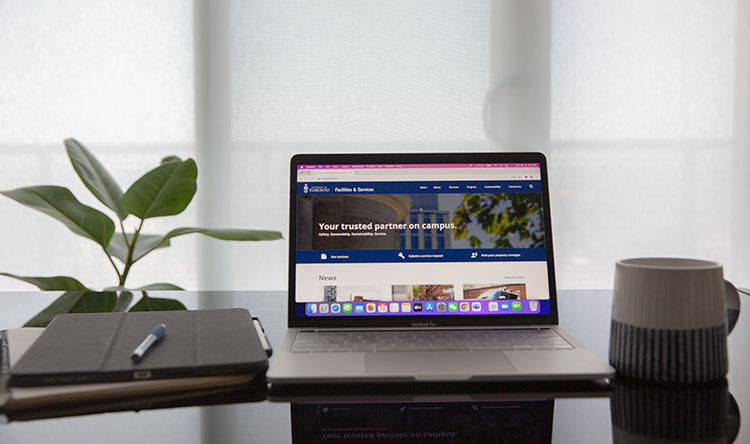Six ways you can make your home office more sustainable
With much of the U of T community working and studying from home right now due to the pandemic, the Sustainability Office is sharing some easy steps to make your temporary home workspace more sustainable.

Kill the watts and the lights
Start by always shutting off lights when you don’t need them. Even if for a few minutes—every watt counts. When the lights are on, to maximize their energy efficiency, switch to LED. LED lights last longer, are more energy-efficient and non-toxic, and even have a lower life cycle cost.
In the winter, turning down the heat in your office space will reduce your carbon footprint. If possible, use a programmable or smart thermostat. Keep blinds open when the sun is shining to absorb solar heat. Wear layers and socks to stay warm and comfortable.
In the summer, close your blinds or drapes in the daytime to block the sun and reduce the need for air conditioning.
And year-round, unplug your devices when you can and turn off your monitors and laptops when you’re away from your home office.
Go paperless
Reading and signing your documents digitally is the home office gold standard.
Letting go of paper is hard for many of us—but it has tremendous benefits for the environment. Not only does it save paper, but it also reduces the chemical and physical waste generated by traditional printing processes. Office printers can release ultrafine particles that can be harmful to human and ecosystem health.
Going paperless can be achieved by getting uncomfortable at first, dedicating time to trying new tools, and building habits to use them. Try OneNote for digital notes, DocuSign for paper signing, and Microsoft Whiteboard—a collaborative digital canvas—for brainstorming or making meetings more engaging learning.
When you absolutely must print, do so in black and white, double-sided, and on Forest Stewardship Council (FSC) certified paper that is made of responsibly sourced wood fibre. Bring those good practices back to the office and encourage others!
Reuse first
There are many ways to minimize waste in your home office.
When setting up your at-home workspace, consider second-hand pieces. Conversely, if you have older desk furniture you’re looking to renew, give it a second chance with aesthetic and ergonomic updates, if possible. If not, find a second home for it by selling it online or donating it.
If you like the fizz—get a sparkling water maker to eliminate disposable bottles. Drinking plenty of non-bottled water is good for you, your wallet, and the environment. Similarly, move away from single-serve coffee pods as they often end up in landfills.
And when you run errands during a break, make sure your tote tags along. Plastic bags are harmful to the environment from their production to their disposal.
Reduce your waste
Use your home office as an opportunity to consume mindfully and to divert waste.
Day-to-day, cooking your lunches is the most sustainable option. When you do order takeout, ask for no plastic cutlery, napkins, or extra sauce
For your lunch and snacks, eat more vegetables and legumes. Minimizing meat and dairy consumption is the single biggest way to reduce your environmental impact. For example, producing beef-based protein emits nearly 40 times more carbon dioxide than producing the same amount of bean-based protein.
Don’t forget to check, sort, and recycle all paper and containers based on your local guidelines. Recycling reduces carbon emissions and the amount of landfill waste. Recycling also conserves vital natural resources like timber, water, and minerals.
Connect with nature
Being indoors in front of a screen all day can be draining. Connect with nature—both indoors and out.
Research shows that offices featuring connections to nature, such as plants, have a more positive impact on employee well-being.
Invest in air purifying plants. Plants such as an areca palm or a snake plant will help create a more welcoming, natural space in your home office while also filtering some toxins from the air.
Surround your office space with natural finishes and décor. Simple additions such as artwork of natural landscapes or unfinished wooden coasters can enhance your mood, morale, and focus.
Boost your wellbeing by intentionally getting active, getting outdoors, and connecting with natural spaces around your home. Deepen your relationships within your neighbourhood and with your colleagues online to help you stay socially connected and protect yourself from feelings of isolation.
Get ready, set, go!
Competition is healthy and a great motivator.
Setting sustainability goals, defining the parameters of the competition, gathering data, and keeping score will make the competition fun and fruitful.
Challenge your coworkers to see who can use the least amount of energy or generate the least waste in a month.
Want to go beyond the basics? Check these out:
Set up—Set up your home office where you can use natural light. Paint your walls white and hang mirrors to maximize the use of natural light.
Star up—Explore purchasing Energy Star certified office equipment to use up to 30% less energy.
Offset—Did you know that you can reduce your emissions footprint and support renewable energy in Canada through Bullfrog Power? Learn more about Bullfrog Power.
Get ambitious—Set yourself an ambitious target of an entirely zero-waste home office. This is challenging and involves scrutinizing everything that comes into your home office, such as purchasing ingredients for all your homemade lunches and coffee with compostable or reusable packaging.
